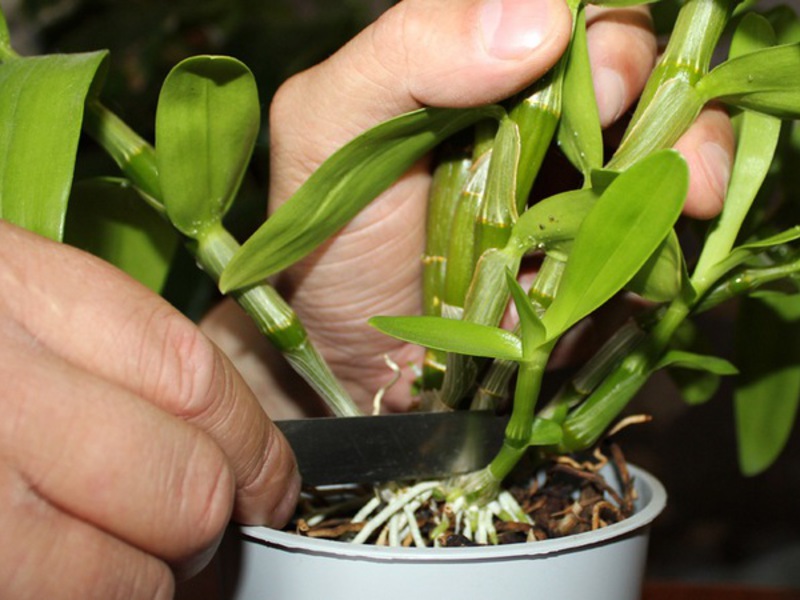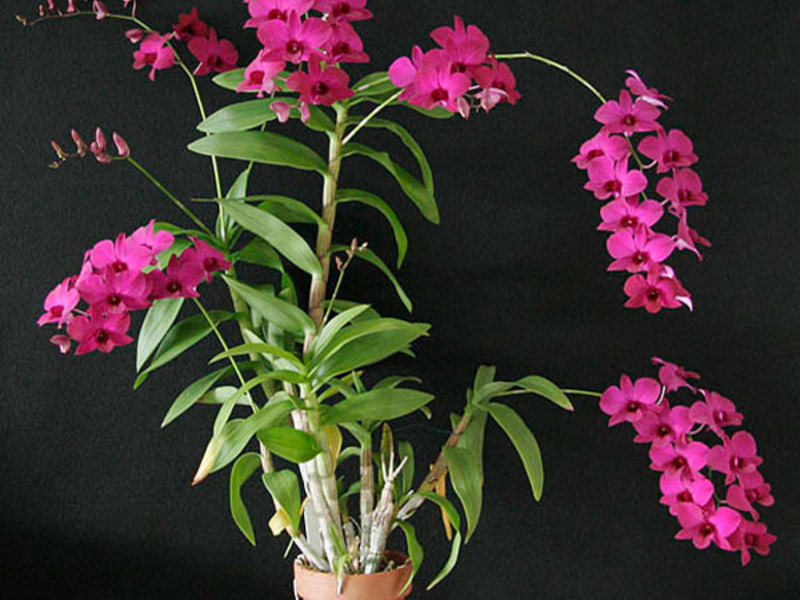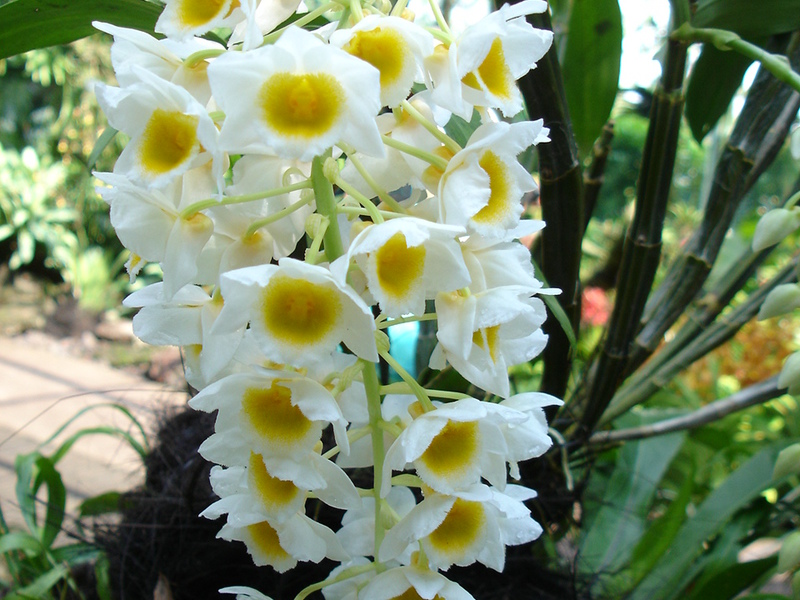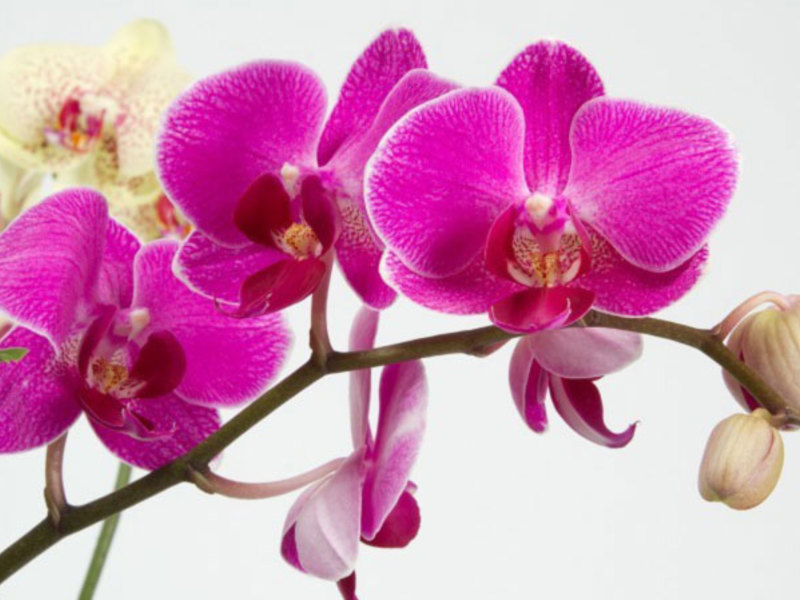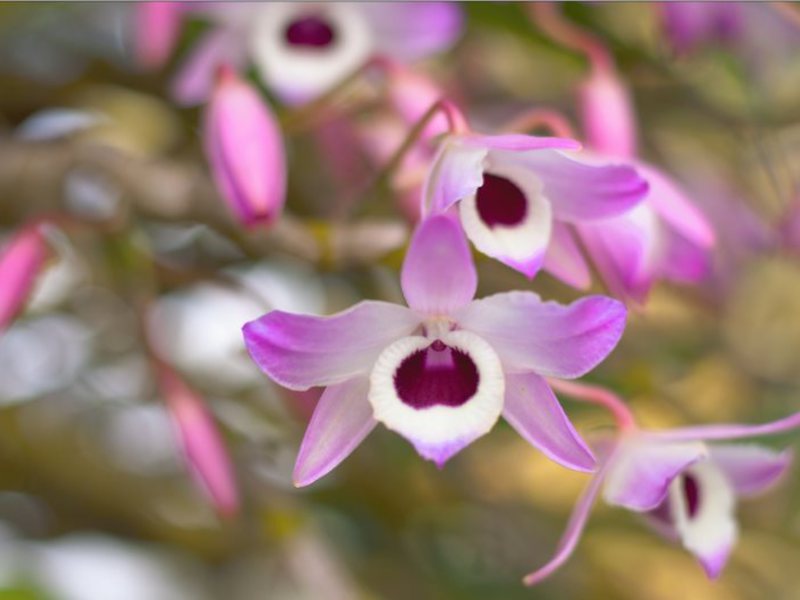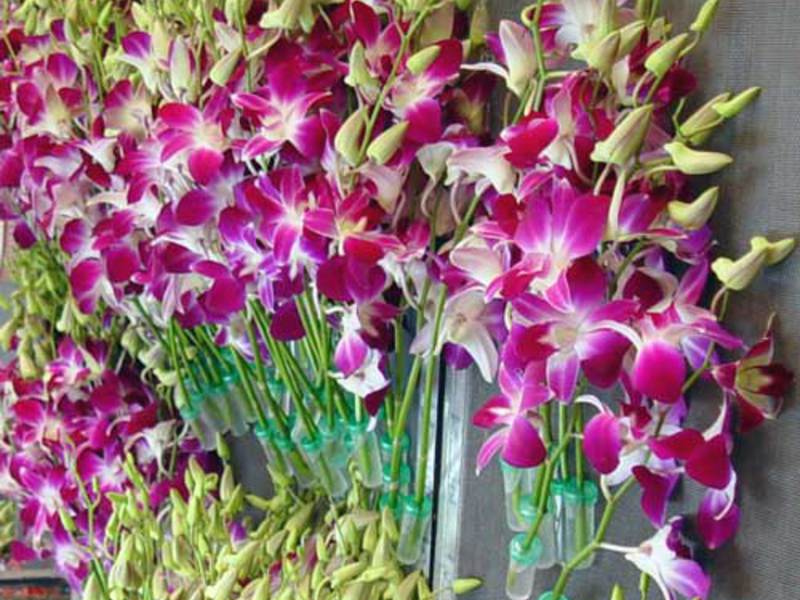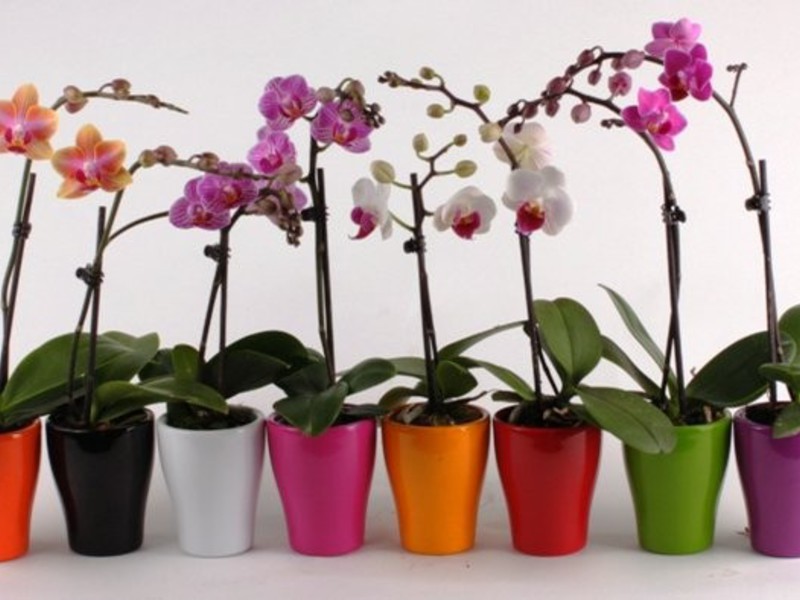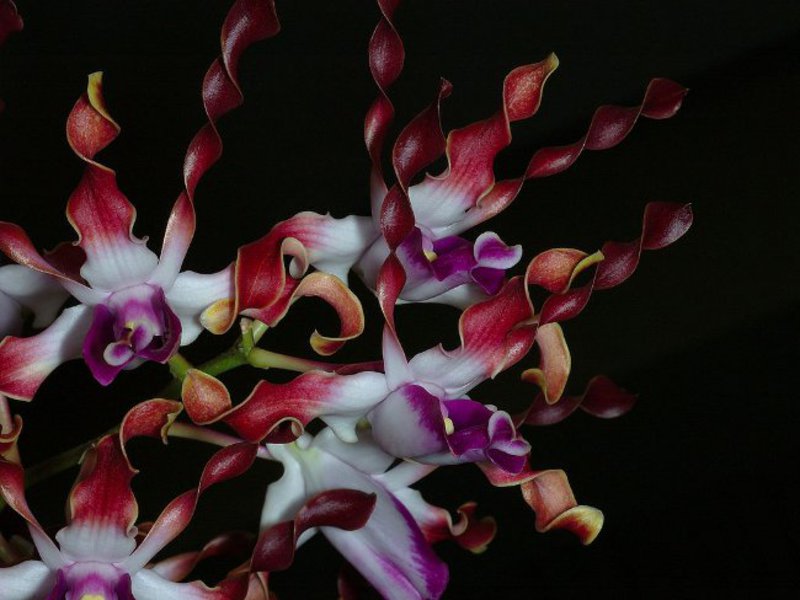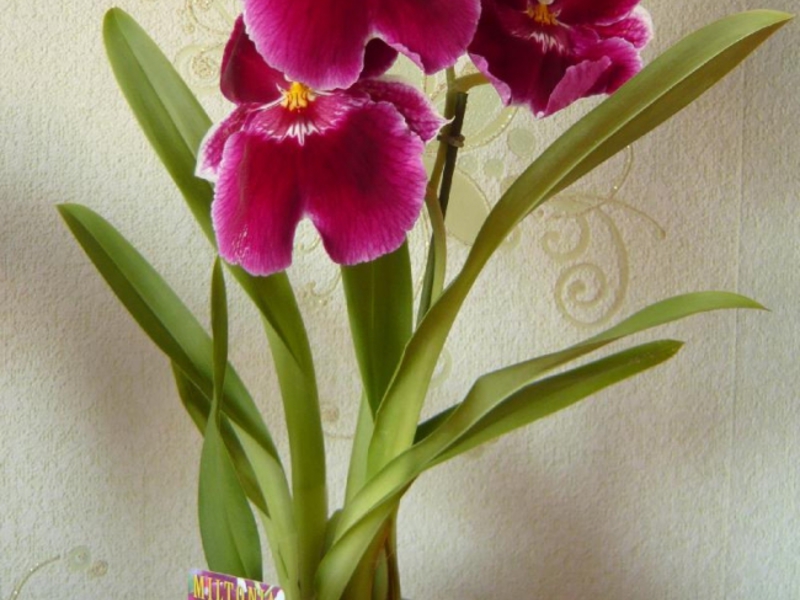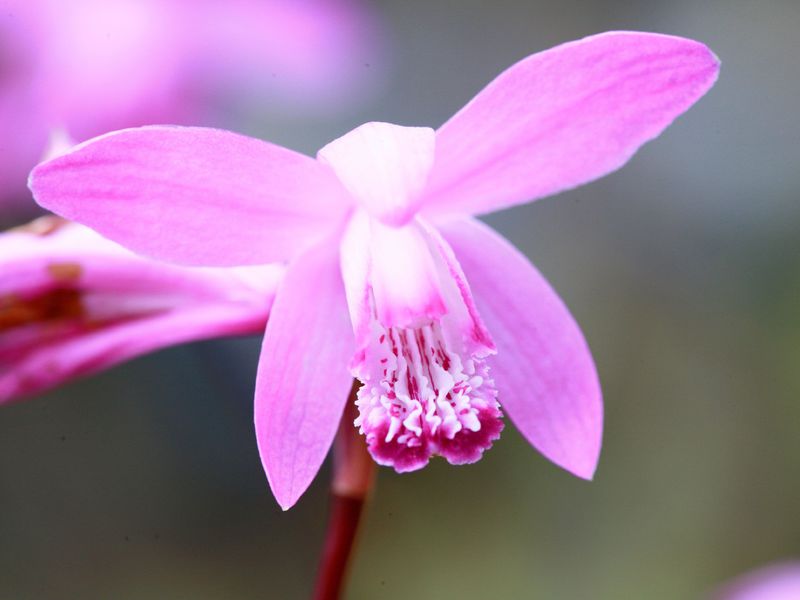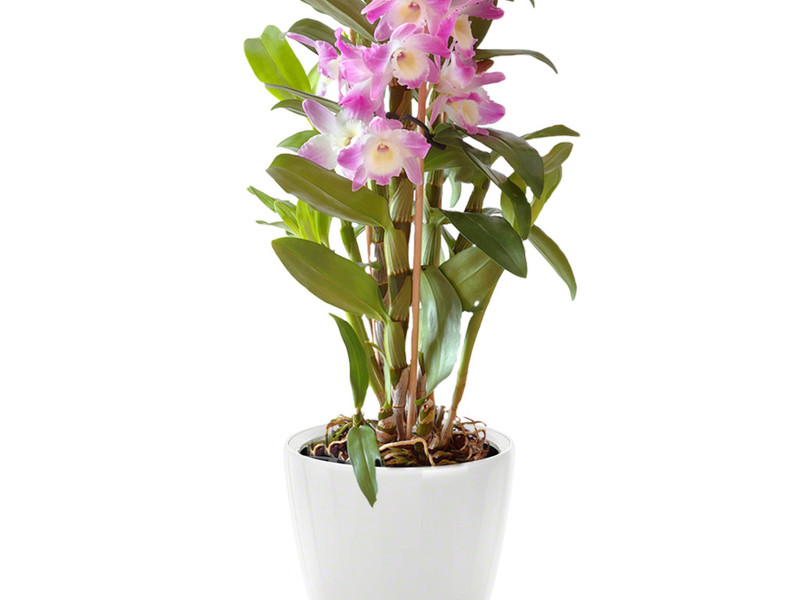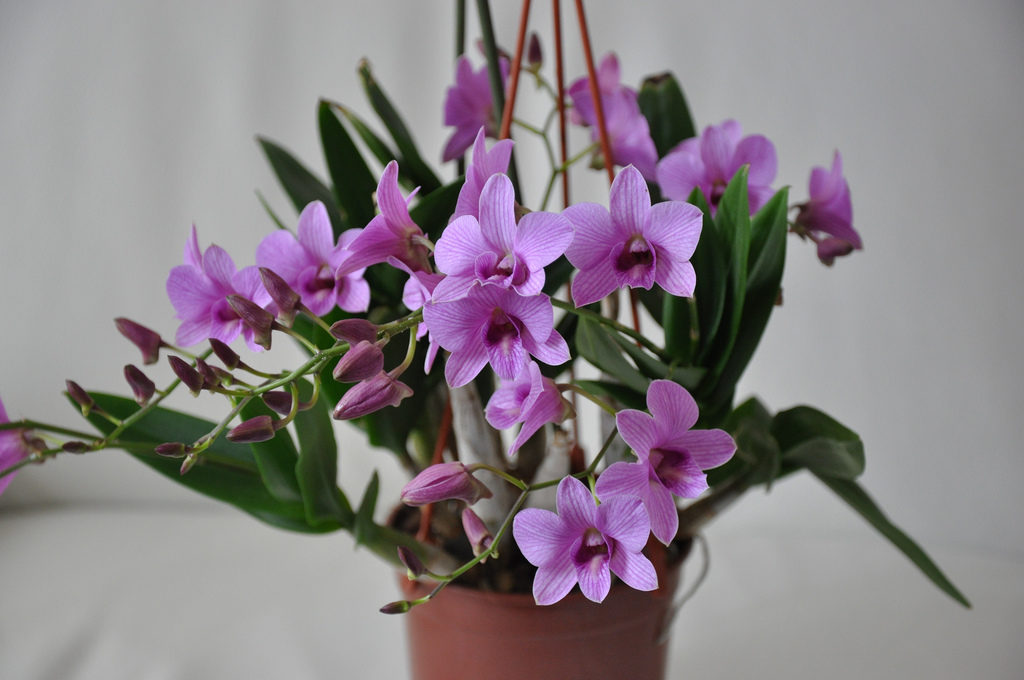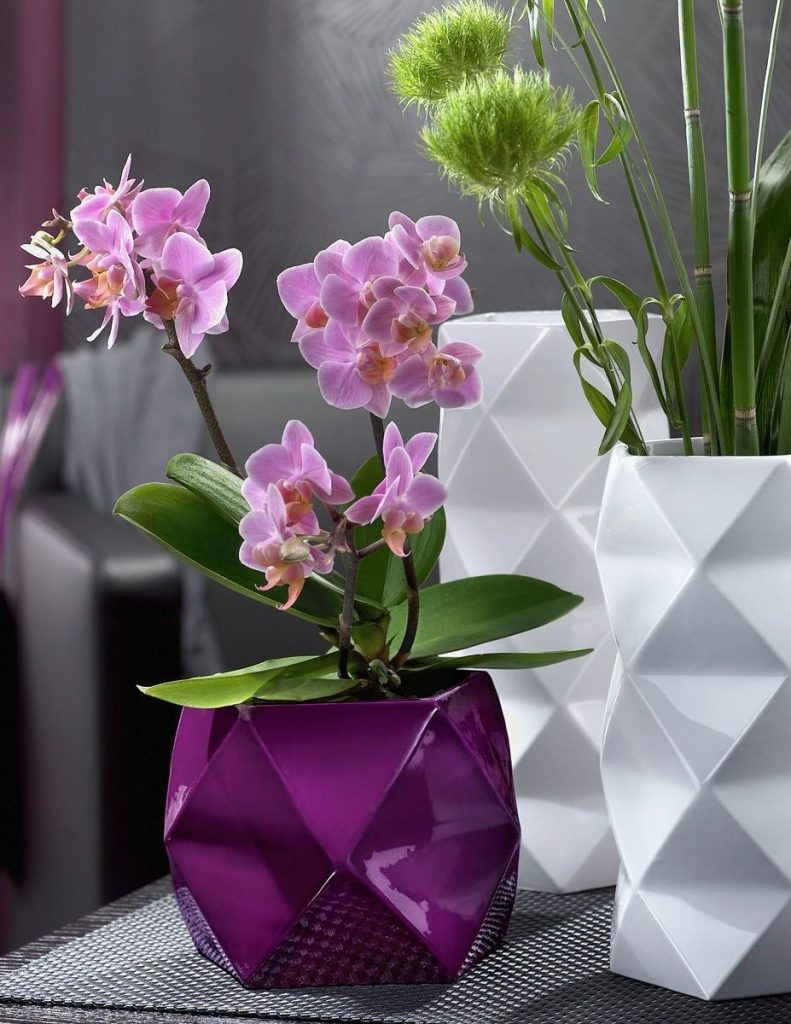Dendrobium Orchid is a small epiphyte with unusual flowers that cover the entire cylindrical stem of the plant. In nature, orchids of this species grow on trees, ground or rocks. This justifies the name of the plant, which in translation means "living on a tree." Breeders have developed hybrid forms of dendrobiums that grow and bloom well at home. Observing the simple conditions of their growing, you can achieve long and abundant flowering.
Content
Dendrobium orchid: photos of species, names and descriptions
Genus dendrobium has more than 1000 species, the cylindrical stem of which grows from 40-90 cm. Lanceolate leaves are alternately located on the stem. Orchid flower stalks consist of 1-4 flowers. The diameter of each of them is about 6-8 cm. Peduncles are located in the axil of almost every leaf. The color of the flowers can be white, lilac, orange, yellow, or even two and three colors.
Popular types of dendrobium
Since there are so many types of dendrobium, it is simply impossible to determine which of them is the most beautiful. Among gardeners, the most attractive for home growing are the following types:
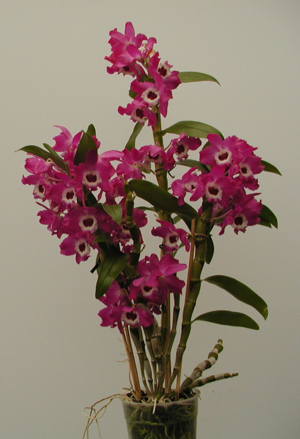 Dendrobium Parisha differs in fleshy open or hanging stems, growing up to 30-40 cm. Each stem is shrouded in a whitish base of leaves and has thickenings at the nodes. The oblong leaves have a sharp shape with a slightly incised top. Flowers grow up to 10 cm in diameter and are located on leafless peduncles. They can be lilac or pink, but be sure to darken a little towards the ends. The rounded or diamond-shaped lip of the flower is usually white or pink-amethyst. At the base, it is decorated with two dark purple spots.
Dendrobium Parisha differs in fleshy open or hanging stems, growing up to 30-40 cm. Each stem is shrouded in a whitish base of leaves and has thickenings at the nodes. The oblong leaves have a sharp shape with a slightly incised top. Flowers grow up to 10 cm in diameter and are located on leafless peduncles. They can be lilac or pink, but be sure to darken a little towards the ends. The rounded or diamond-shaped lip of the flower is usually white or pink-amethyst. At the base, it is decorated with two dark purple spots.- Dendrobium Lindley - It is an epiphytic plant with short stems like a bulb, the height of which is only about 8 cm. On each oblong-rounded stem, only one leathery oblong leaf grows. Golden yellow fragrant flowers with a large pubescent lip are located on long, loose, hanging peduncles.
- King's Dendrobium is distinguished by its rigid cylindrical stems that grow thinner upwards, growing up to 30 cm in length. Each stem is covered with a whitish membranous base of lanceolate leaves. The small-flowered apical raceme is collected from fragrant small flowers, which can be from white to bright purple. The lip of the flowers has three lobes, and their sepals are spliced on the sides.
- Dendrobium densely colored Is an epiphytic plant with tetrahedral, erect stems thickening upward. Lanceolate or ovoid narrow leaves of 3-4 grow at the very top of the stem. In the upper part of the shoots, hanging clusters of dense inflorescences are formed, which consist of a large number of fragrant flowers.Each flower represents elongated obtuse sepals, from which rounded yellow petals, finely cut along the edge, grow. The pubescent lip of the flower has a yellow-orange tint. Breeders have developed a large number of dendrobium bush hybrids that can be grown at home.
- Dendrobium Nobile or noble is a large plant with straight, fleshy stems. Arranged in two rows, leathery sessile leaves have an oblong shape. On last year's leafless shoots, short peduncles are formed, consisting of two or three flowers with ovoid petals and oblong sepals. Whitish-cream at the base and lilac or pink at the edges, the flowers are distinguished by a white pubescent lip with a dark purple spot at the base. When grown at home, dendrobium noble is quite unpretentious in care.
- Dendrobium phalaenopsis Is a large orchid with fleshy long stems. The plant is distinguished by long lanceolate leaves and peduncles growing only in the upper part of the stem, which can grow up to 60 cm in length. Dendrobium phalaenopsis is also remarkable for its large flowers with a diameter of 3-8 cm. Each inflorescence can grow from 5-40 flowers. The orchid blooms for two to three months with flowers, the color of which can be from white to bright pink or even dark red or crimson. Inflorescences retain their freshness for a long time, which is why they are very popular among florists who make up amazing bouquets of them.
Breeders have bred a large number of dendrobium phalaenopsis hybrids, which differ in the color of the inflorescences, as well as the timing and duration of flowering.
Growing dendrobiums at home
Hybrid bred by breeders are most adapted to indoor conditions. types of orchids... But even to grow them, you need to have experience in floriculture, or read the care instructions in detail.
Lighting and temperature control
 Orchids are light-loving plants, therefore, they need to free up a well-lit place without direct sunlight. Otherwise, the leaves of the plant may get burned. The best option for growing orchids is west and east windows. They must be removed from the windowsills of the southern windows from the midday sun.
Orchids are light-loving plants, therefore, they need to free up a well-lit place without direct sunlight. Otherwise, the leaves of the plant may get burned. The best option for growing orchids is west and east windows. They must be removed from the windowsills of the southern windows from the midday sun.
In late summer and autumn, orchids begin to ripen shoots, so they need the maximum amount of light. For this, it is recommended to use additional lighting with fluorescent lamps.
Required temperature conditions depends on the type of dendrobium:
- Dendrobium phalaenopsis in the summer time loves high air temperatures, which can be up to + 27C. You need to make sure that the temperature drops at night.
- Dendrobium is magnificent and King's Dendrobium can be taken outdoors in summer. The place for them is chosen bright, but protected from direct sunlight. During the winter, orchids should be kept in a cool, dry place.
- Dendrobium noble and other deciduous hybrids from November to November are transferred to a cool room with an air temperature of 10-14C. They return to their usual place only after new buds begin to grow.
During the period of active growth, almost all epiphytes like high temperatures up to + 25C during the day, and about + 20C at night.
Watering and air humidity
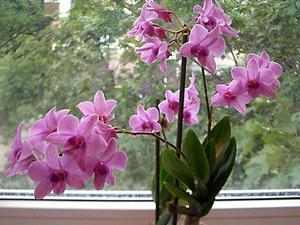 During the period of active growth, orchids need abundant watering. If the room is warm, then the plant is watered twice a week. The orchid soil should dry well before the next watering. Water from the pallet must be poured 15 minutes after watering the plant... During this time, the flower will pick up the missing moisture. If the water is in the pan for a long time, the roots of the plant may begin to rot.
During the period of active growth, orchids need abundant watering. If the room is warm, then the plant is watered twice a week. The orchid soil should dry well before the next watering. Water from the pallet must be poured 15 minutes after watering the plant... During this time, the flower will pick up the missing moisture. If the water is in the pan for a long time, the roots of the plant may begin to rot.
Water for irrigation should be at room temperature, separated.During the dormant period, dendrobiums are watered symbolically, preventing the root system from drying out.
Orchids are very fond of high humidity. To do this, they can be sprayed daily, doing this so that water does not fall into the leaf axils. Otherwise, the trunk will start to rot. Therefore, it is best to put a flower pot and a tray in a container with wet peat, expanded clay or moss.
Fertilizing dendrobiums
From April to September, that is, during the period of active growth, orchids are fed twice a month. For this are used special complex fertilizers for orchids. You need to dilute the fertilizer very carefully, since a strong concentration of the solution can burn the roots of the plant. Therefore, experienced florists recommend making the concentration two times weaker than that indicated on the instructions.
Evergreen orchids, such as Phalaenopsis dendrobium, are fed with phosphorus-potassium fertilizers in winter. Deciduous plants - nitrogen fertilizers no more than twice a month.
Transplant features
 Dendrobium transplant is very painful, therefore it is done no more than once every two to three years. Transplanting is necessary in the spring, when the plant begins to grow actively. It is recommended to use only special soil for epiphytic orchids. You can yourself prepare an earthen mixture for dendrobium transplant, taking for this:
Dendrobium transplant is very painful, therefore it is done no more than once every two to three years. Transplanting is necessary in the spring, when the plant begins to grow actively. It is recommended to use only special soil for epiphytic orchids. You can yourself prepare an earthen mixture for dendrobium transplant, taking for this:
- peat soil;
- sphagnum;
- pine bark;
- charcoal.
The dendrobium pot should be ceramic or plastic, but not transparent, which is only suitable for phalaenopsis. A drainage layer must be placed on the bottom of the pot.
Dendrobium care after flowering
As soon as the last flower withers on the orchid, the peduncle must be removed, watering must be gradually stopped, and the plant itself must be transferred to a cool place.
With a short daylight hours in winter, dendrobium can stop growing, hibernate and freeze. The plant will not die, but it will be much worse to develop and bloom in the future. Therefore, in winter, orchids are recommended to be supplemented with a phytolamp.
If, nevertheless, the dendrobium has stopped growing, that is, "fell asleep", it must be removed from heat sources and practically stop watering. Watering the orchid should be started only when its new sprouts will stretch 2-3 cmand take root.
In order for the dendrobium to bloom again in the spring, flower growers in the winter season resort to some tricks:
- The plant is watered until the new growth catches up with the old bulbs.
- After that, the orchid is transferred to a cool room, and watering practically stops.
- You need to start watering the plant again only after the buds that have appeared begin to open. Otherwise, children will start growing instead of flowers.
They have a good effect on flowering and drops in day and night temperatures, which should be at least 5-7C.
Reproduction of dendrobium
This type of orchid reproduces in two ways:
- dividing the bush;
- cuttings.
Dividing the bush
 After flowering, a large mature shrub is usually transplanted into a new pot. At this time, it can be immediately divided. To do this, the flower is removed from the pot, cleaned of the earthen mixture and divided into parts.
After flowering, a large mature shrub is usually transplanted into a new pot. At this time, it can be immediately divided. To do this, the flower is removed from the pot, cleaned of the earthen mixture and divided into parts.
The division must be done carefully. First roots unravel, and then with the help of a sharp and clean knife, cut off what could not be unraveled. Slices are processed with garden pitch or crushed coal.
Each section should have 2-3 young sprouts and the same number of mature bulbs. Young shoots are planted in miniature separate containers, watered and placed in a well-lit place with an air temperature of about + 22C.
Cuttings
Only deciduous dendrobium species can be propagated in this way. Cuttings are cut from pseudo-bulbs, which are previously separated from the mother bush. Each stalk should be about 10 cm long. The cuts are processed with crushed charcoal or garden pitch.
Cuttings first placed in moist sphagnum moss, and after the roots appear, they can be planted in the soil for orchids. In order for the slices to heal well, it is better not to water the cuttings for the first two weeks.
For better rooting, experienced growers of sphagnum moss are placed together with pieces of pseudo-bulbs in a plastic bag with a fastener. Each such package contains two cuttings, which should be stored at a temperature of 22-25C in bright diffused light. Packages are opened every day, cuttings are ventilated. The first roots should appear in two to three weeks. Young dendrobium, propagated by cuttings, will bloom only after two to three years.
The recommendations above are suitable for most types of dendrobiums. And yet, in order for your pet to please you with its appearance and beautiful, long flowering, you should find out what species it belongs to and study the individual characteristics of caring for it.
